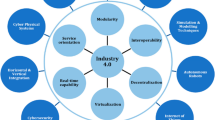Abstract
Most works on Cyber-Physical Systems (CPS) are based on classic hardware infrastructures made of sensors, actuators and processing devices. Usual self-configuration technologies, then, do not allow humans to be integrated in CPS as service providers. Therefore, in this work we propose a new self-configuration technology for humanized CPS. The proposed technology uses simple binary and mathematical operations in order to reduce the convergence time, improve the scalability and address the dynamism introduced by humans into CPS. Besides, a human-oriented quality-of-service algorithm based on the Maslow pyramid is also introduced. Moreover, an experimental validation is conducted in order to validate the proposed solution as a useful and scalable self-configuration technology for humanized Cyber-Physical Systems.









Similar content being viewed by others
References
Bitalino (2014). Project Bitalino [online]. http://www.bitalino.com/. Accessed 26 March 2016
Bordel Sánchez B, Alcarria R, Martín D, Robles T (2015) TF4SM: a framework for developing traceability solutions in small manufacturing companies. Sensors 15(11):29478–29510
Bordel B, Alcarria R, Pérez-Jiménez M, Robles T, Martín D, de Rivera DS (2015) Building smart adaptable Cyber-Physical Systems: definitions, classification and elements. In: ubiquitous computing and ambient intelligence. Sensing, processing, and using environmental information, Springer International Publishing, Berlin, pp 144–149
Cardenas AA, Amin S, Sastry S (2008) Secure control: towards survivable cyber-physical systems. In: the 28th International Conference on Distributed Computing Systems Workshops (pp 495–500) IEEE
Cohen S, Kamarck T, Mermelstein R (1983) A global measure of perceived stress. J health soc behav 24(4):385–396
Colombo AW, Karnouskos S, Mendes JM (2010) Factory of the future: a service-oriented system of modular, dynamic reconfigurable and collaborative systems. Artificial intelligence techniques for networked manufacturing enterprises management. Springer, London, pp 459–481
Cotterman WW, Kumar K (1989) User cube: a taxonomy of end users. Commun ACM 32(11):1313–1320
De Lemos R, Giese H, Müller HA, Shaw M, Andersson J, Litoiu M, Weyns D (2013) Software engineering for self-adaptive systems: a second research roadmap. Springer, Berlin Heidelberg, pp 1–32
Dillon T, Potdar V, Singh J, Talevski A (2011) Cyber-Physical Systems: providing quality of service (QoS) in a heterogeneous systems-of-systems environment. In: digital ecosystems and technologies Conference (DEST), 2011.In: Proceedings of the 5th IEEE International Conference on (pp. 330–335). IEEE
Dillon TS, Zhuge H, Wu C, Singh J, Chang E (2011b) Web-of-things framework for cyber–physical systems. Concurr Comput Prac Exp 23(9):905–923
Domingues J, Damaso A, Nascimento R, Rosa N (2011) An energy-aware middleware for integrating wireless sensor networks and the internet. Int J Distrib Sens Netw 2011:672313. doi:10.1155/2011/672313
European commission (2005). Proyect Hydra. [online]. http://www.hydramiddleware.eu/articles.php?article_id=68. Accessed 26 March 2016
Hoang DD, Paik HY, Kim CK (2012) Service-oriented middleware architectures for cyber-physical systems. Int J Comput Sci Netw Secur 12(1):79–87
JaSkowski P, Rybarczyk K, Jaroszyk F, Lemanski D (1995) The effect of stimulus intensity on force output in simple reaction time task in humans. Acta Neurobiol Exp 55:57
Kao HA, Jin W, Siegel D, Lee J (2015) A cyber physical interface for automation systems—methodology and examples. Machines 3(2):93–106
Keddis N, Kainz G, Buckl C, Knoll A (2013) Towards adaptable manufacturing systems. In: Industrial Technology (ICIT), 2013 IEEE International Conference on (pp 1410–1415). IEEE
Lee EA (2006) Cyber-physical systems-are computing foundations adequate. In position paper for NSF workshop On Cyber-Physical Systems: research motivation, techniques and roadmap (vol 2)
Maslow AH (1943) A theory of human motivation. Psychol Rev 50(4):370
Millot JL, Brand G, Morand N (2002) Effects of ambient odors on reaction time in humans. Neurosci Lett 322(2):79–82
Mönks U, Trsek H, Dürkop L, Geneiß V, Lohweg V (2014) Assisting the design of sensor and information fusion systems. Procedia Technol 15:35–45
Park J, Lee S, Yoon T (2015) Designing goal model for autonomic control point of Cyber-Physical Systems (CPS). Indian J Sci Technol 8(19). doi:10.17485/ijst/2015/v8i19/76692
Schirner G, Erdogmus D, Chowdhury K, Padir T (2013) The future of human-in-the-loop cyber-physical systems. Computer 1:36–45
Wang T, Niu C, Cheng L (2014) A two-phase context-sensitive service composition method with the workflow model in cyber-physical systems. In: Computational Science and Engineering (CSE), 2014 IEEE 17th International Conference on (pp 1475–1482). IEEE
Acknowledgments
The research leading to these results has received funding from the Ministry of Economy and Competitiveness through SEMOLA project (TEC2015-68284-R) and from the Autonomous Region of Madrid through MOSI-AGIL-CM project (grant P2013/ICE-3019, co-funded by EU Structural Funds FSE and FEDER).
Author information
Authors and Affiliations
Corresponding author
Ethics declarations
Conflicts of interest
The authors declare that there is no conflict of interest regarding the publication of this paper.
Rights and permissions
About this article
Cite this article
Bordel, B., Alcarria, R., Martín, D. et al. Self-configuration in humanized Cyber-Physical Systems. J Ambient Intell Human Comput 8, 485–496 (2017). https://doi.org/10.1007/s12652-016-0410-3
Received:
Accepted:
Published:
Issue Date:
DOI: https://doi.org/10.1007/s12652-016-0410-3




